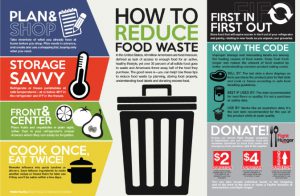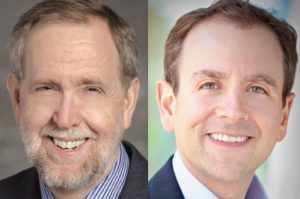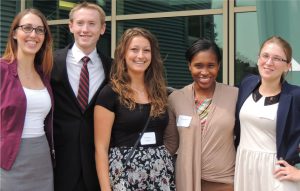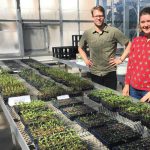BioCycle September 2015
Food For People, Food For Soil Workshop
On Monday, October 19, 2015, BioCycle and U.S. EPA Region 1 cosponsor an all-day workshop, Food For People, Food For Soil. The purpose of the workshop is to bring the food rescue/donation universe and the organics recycling/composting community together to have a conversation at the same table. What is your role in managing edible food available for donation and/or nonedible food for recycling? How do we complete the cycle by building healthy soils with compost to grow more food? How do we get more food to those in need?
Workshop participants will:
Gain inspiration from two featured speakers — Doug Rauch of The Daily Table and Andrew Shakman of LeanPath.
Dispel myths and learn the fundamentals about food donation.
Learn how organics recyclers, including collection services and processors, are critical cogs in the food rescue wheel.
Network with colleagues across the food system life cycle: growers, distributors, retailers, rescue and donation organizations, organics collection services, composters and digester operators, and Food For People, Food For Soil advocates.
In addition to Rauch and Shakman, Food For People, Food For Soil panelists include: Sasha Purpura, Food for Free Committee, Inc.; Tim Hall, CERO Cooperative, Inc.; Ona Balkus, Harvard Food Law & Policy Clinic; James McSweeney, Compost Technical Services; Bruce Fulford, City Soil & Greenhouse; Elli Blaine, Save that Stuff; Jessie Banhazl, Green City Growers; and Craig Lapine, Cultivating Communities. www.biocyclerefor.com
Supermarket Highlights Wasting Less
 Weis Markets, Inc., based in Sunbury, Pennsylvania, expanded the focus of its annual Fight Hunger awareness month this September to also educate its customers about food waste. The centerfold of its latest Healthy Bites magazine provides simple tips for food storage, preparation and understanding sell by dates. “Helping our customers stretch their food dollars and preventing food waste at home can have a big impact and help reduce the environmental impact,” explains Patti Olenick, Weis Markets’ Sustainability Manager. Taking inventory of what’s already in the refrigerator and pantry and putting food that needs to be eaten in “plain sight” are among the tips. The Fight Hunger donation program enables customers to donate money and receive a Weis Fight Hunger reusable shopping bag, donate a gallon of milk or round up the total cost of their order.
Weis Markets, Inc., based in Sunbury, Pennsylvania, expanded the focus of its annual Fight Hunger awareness month this September to also educate its customers about food waste. The centerfold of its latest Healthy Bites magazine provides simple tips for food storage, preparation and understanding sell by dates. “Helping our customers stretch their food dollars and preventing food waste at home can have a big impact and help reduce the environmental impact,” explains Patti Olenick, Weis Markets’ Sustainability Manager. Taking inventory of what’s already in the refrigerator and pantry and putting food that needs to be eaten in “plain sight” are among the tips. The Fight Hunger donation program enables customers to donate money and receive a Weis Fight Hunger reusable shopping bag, donate a gallon of milk or round up the total cost of their order.
2015 Recipients Of Jerome Goldstein Scholarship Fund
The 2015 Recipients of the Jerome Goldstein Scholarship Fund for EcoEntrepreneuring presented their research to professors, mentors, family, friends and the Goldstein family on August 31, 2015 at Rutgers University EcoComplex, located in Bordentown, New Jersey. Five student interns, ranging from undergraduates to PhD students, researched and explored their topic of choice for nine weeks this summer at the EcoComplex. Rutgers faculty and EcoComplex incubator companies helped and supported the interns. Research projects include:
Hydrogen Production From Methane Steam Over Modified Titanium Dioxide: Ashley Pennington’s project focused on significantly reducing the energy required to produce hydrogen by utilizing methane steam.
Food Waste As A Feedstock for Renewable Power Production by Anaerobic Digestion: Alessandra Looman collected data by calling nine different types of facilities in four sectors to get their food waste generation volume. Using that data, she created an interactive data map that shows the different generation rates of many facilities in New Jersey.
Hydroponic Amaranth: Kevin Marceski raised hydroponic amaranth to improve the availability of specialty foods consumed by ethnic groups in New Brunswick, New Jersey. He researched the science behind amaranth, as well as marketing and branding — including selling the harvest at local farmers markets.
Environmental Assessment of Organic Polymer Light-Emitting Diodes: Catrice Carter researched organic light emitting diodes. She focused on the benefits, drawbacks, and solutions by looking at assessments and system boundaries.
New Jersey Energy Resource Network Update: Julia Burmistrova evaluated the New Jersey Clean Energy Resource Network database website to determine options for making it more interesting and modern.
The Jerome Goldstein Scholarship Fund For EcoEntrepreneuring supports student researchers at the Rutgers University EcoComplex in Bordentown, New Jersey. The EcoComplex integrates composting, anaerobic digestion, compost utilization, agricultural production, renewable energy and enterprise development. Jerome Goldstein (1931-2012), a graduate of Rutgers University, was the founding Editor and Publisher of BioCycle and founder of The JG Press, Inc. — Quinn Daugherty
Massachusetts’ Turf Nutrient Rule
In 2014, the Massachusetts Department of Agricultural Resources (MDAR) proposed a new fertilizer nutrient management regulation focused on reducing phosphorus (P) runoff and leaching that contribute to eutrophication of surface waters. This nutrient management regulation was driven by a law passed by the Massachusetts legislature in 2012 that required MDAR to adopt regulations by 2014 that would reduce nonpoint P sources. Pressure to get the regulation in place led MDAR to promulgate a final regulation late this spring with the first effective date — for fertilization of turf — being June 5, 2015. The agricultural parts of the regulation go into effect on December 5, 2015. “The promulgation caught a lot of stakeholders by surprise,” explains Ned Beecher, Executive Director of the North East Biosolids and Residuals Association (NEBRA). “MDAR sought comments on its proposed rule in April 2014. NEBRA submitted comments, criticizing the proposed regulation’s lack of clarity and its likely impacts on the recycling of organic residuals. The Massachusetts Farm Bureau Federation and others provided comments as well. In rushing the regulation into effect, MDAR provided no response to comments and no public warning. And the final version is quite similar to that proposed in 2014; it remains confusing and difficult to interpret.”
A Fact Sheet issued by MDAR in June 2015 about the plant nutrient regulations for “nonagricultural turf and lawns” states that “phosphorus-containing fertilizer may only be applied when a soil test indicates that it is needed or when a lawn is being established, patched or renovated.” It also states “these regulations impact anyone who applies plant nutrient materials (including commercial fertilizer and various other plant nutrient materials) to both agricultural and nonagricultural land, including lawn and turf.” At a University of Massachusetts Extension workshop on the new rules in August, it was noted that those soils with high soil test P levels, where additional P will generally not be allowed, are as follows (in order of highest current P in soil to lower P in soils): flower beds, home vegetable gardens, small vegetable farms (organic farms included), dairy farms, other agriculture, and golf courses.
“The growing volumes of organic residuals being diverted, as a result of the Massachusetts Department of Environmental Protection’s disposal ban on commercial organics, will now have fewer outlets within the state,” says Beecher. “The question, to which we don’t know the answer, is how significant are these potential outlets for organic residuals — digestates and composts — coming from landfill-diverted residuals? The NEW restriction on applying P means that some, or perhaps a great deal, of the market for organic residuals has been removed. All residuals — food waste, biosolids, composts and digestates —contain P and will not be useable in many areas. In some states that have adopted restrictions on P fertilizers, organic residuals have been exempted; not so in Massachusetts.”
The MDAR nutrient management rules will be addressed during the NEBRA/NEWEA-sponsored Hot Topics session at BioCycle REFOR15 . Additional details on the NEBRA website
Hawaii’s First PAYT
On July 1, Kauai, the “garden” island, officially launched the state’s first Pay-As-You-Throw (PAYT) waste collection program. Passed in October 2014, the PAYT ordinance replaces the $12/month flat-fee collection rate (for a 96-gallon cart) the island adopted in 2012, and went into effect at the same time Kauai inaugurated island-wide automated collection. The PAYT plan had recommended phasing in 64-gallon carts as the default choice because that is the desired customer behavior, but the County decided to keep the 96-gallon as the default to avoid having to deal with nonresponsive customers who already had service. But to entice customers to switch, the County set the monthly cost of 96-gallon carts at $18 versus $10 for a 64-gallon version for Phase 1 of the PAYT plan.












